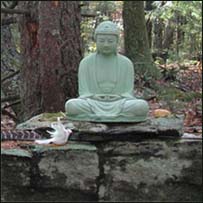|
|
 |
Please support Dharma Seed with a 2025 year-end gift.
Your donations allow us to offer these teachings online to all.

|

|

|
The greatest gift is the
gift of the teachings
|
|

|
| |
|
Dharma Talks
|
2020-05-28
Day 3 - Meditation Instructions - Open Palm Attention
51:56
|
|
Nathan Glyde
|
|
|
Expanding the world through skilful wholesome modes of relating. When there is an object in attention there is always some degree of push or pull happening. The contraction is what holds attention there. It is not something we’re doing wrong, it is the nature of experience. What happens when we invite an opening in the contraction, either in the body sense, or the sense of awareness, or by bringing in a bit more metta in the atmosphere of attending?
|
|
Gaia House
:
Waking the heart, Expanding the world
|
|
|
2020-05-27
Metta Undefined
42:58
|
|
Nathan Glyde
|
|
|
Letting metta be expansive, unconstrained, vaster than vast, beyond boundaries, so that it can fabricate more and more well-being. Metta is an expression and experience of non-dukkha, it is a skilful delightful way of relating that brings wellbeing, it is a compass for practice, and it is so much more too.
|
|
Gaia House
:
Waking the heart, Expanding the world
|
|
|
2020-05-27
From the Ordinary Habitual Mind to the Buddha-Mind 19: Transforming Reactivity 3
65:50
|
|
Donald Rothberg
|
|
|
After a review of our last two sessions exploring the nature of dukkha as reactivity and how to practice to transform reactivity, in the context of the Buddha's teachings of Dependent Origination and the Two Arrows, we explore a third aspect of practice. Some of our experiences of reactivity, particularly those in which there are repetitive and habitual patterns, sometimes open up to reveal old and relatively unconscious material, part of our "ignorance," giving us the chance to access and transform such material. This can occur, for example, when there is trauma, or when there are limiting beliefs originating from childhood (or sometimes later) related to psychological and/or social conditioning. A general model is given of four steps in the transformation of such material.
|
|
Spirit Rock Meditation Center
:
Monday and Wednesday Talks
|
|
|
|
|